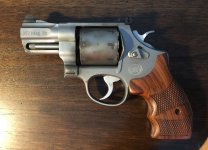I have read reasonable opinions, but I wonder if anyone is willing to share their personal experience with high round count revolvers (perhaps 25,000+), and the related wear and repair trends.
I'm not interested in what should happen, but rather personal experience with what does happen with revolvers owned since new, particularly 357/38 and 44 K, L, and N frames.
I know there can be no one answer, given vastly different loads, etc.
If this has been well covered, perhaps link me to an old thread. I did try a search. Thanks!
I'm not interested in what should happen, but rather personal experience with what does happen with revolvers owned since new, particularly 357/38 and 44 K, L, and N frames.
I know there can be no one answer, given vastly different loads, etc.
If this has been well covered, perhaps link me to an old thread. I did try a search. Thanks!
Last edited:

